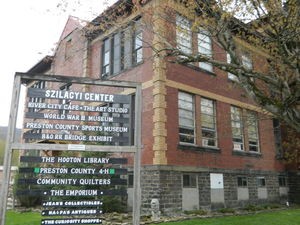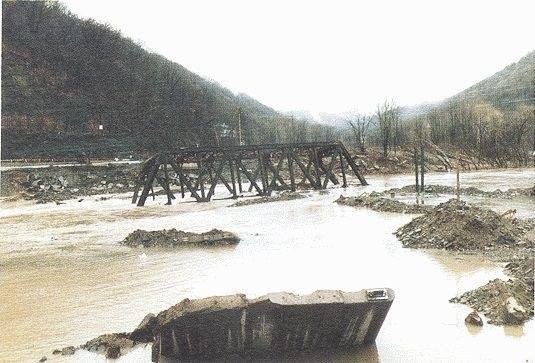The Szilagyi Center for Visual and Performing Arts
Introduction
Text-to-speech Audio
Images
The Szilagyi Center for Visual and Performing Arts. Courtesy of WVNews.com.

The Rowlesburg Bridge over Cheat River after the 1985 flood. Courtesy of WVNews.com.

Backstory and Context
Text-to-speech Audio
Built in 1910 in the Gothic Revival style and expanded with a Colonial Revival addition fifteen years later, the two-story red brick structure that now houses the Szilagyi Center for Visual and Performing Arts served as the Rowlesburg High School until the Cheat River flooded the area in 1985. The building is particularly noteworthy as a survivor of that specific disaster, which devasted the town, the surrounding region, and areas throughout Virginia, West Virginia, Pennsylvania, Maryland, and the District of Columbia. Floodwaters reached historic levels throughout West Virginia and the mid-Atlantic, and Rowlesburg itself became the focus of national attention after NBC anchor Tom Brokaw featured the town in his report on the aftermath of Hurricane Juan. After the flood the town relocated its high school and sold the building on Buffalo Street to Janet and Imre Szilagyi, who used the structure as the headquarters of their local whitewater rafting business. In 2008, the Szilagyis returned the building to Rowlesburg, which reopened it as the Szilagyi Center for Visual and Performing Arts. The center is open on weekends throughout the summer from 11 AM to 4 PM on Saturdays and 12 PM to 4 PM on Sundays. It currently houses a World War II museum, two sports museums, a 4-H museum, research library and Baltimore & Ohio Railroad exhibit, in addition to an auditorium and the River City Café. The Rowlesburg Revitalization Committee also hosts a variety of festivals, concerts, and reenactments at the center on an annual basis.
When the residents of Rowlesburg established their high school on Buffalo Street in 1910, it was the first high school in Preston County other than the one in the county seat of Kingwood. Within the next several years, however, similar secondary educational facilities cropped up across the county as part of an initiative by the West Virginia Department of Education in the early twentieth century to encourage the establishment of high schools across the state. As the years passed, however, the Preston County Board of Education made routine efforts to consolidate and reorganize the district’s high school system, which would have eliminated Rowlesburg’s high school entirely. These efforts peaked first in the 1960s, as a result of the county receiving federal grant money in 1968 to consolidate the high school system from nine high schools into one at Kingwood as part of a Great Society program known as Project D.A.V.E. Ultimately, because the plan faced substantial resistance, the county tabled its plans. But, after over seventy years as Rowlesburg’s high school, the building that now houses the Szilagyi Center became one of the many structures in the town damaged by the flooding that took place across West Virginia and the mid-Atlantic in Hurricane Juan’s aftermath in 1985. The county’s work to rebuild in the flooding’s wake ultimately included the long-awaited consolidation of its high schools. After multiple failed attempts to pass a bond that ensured the consolidation of the county’s schools, voters approved a measure to close all but the facilities at Kingwood in 1989. It took effect two years later.
It is likely that, without the flooding caused by Hurricane Juan, the county’s consolidation plans may have been further delayed. Juan, a tropical cyclone, made landfall west of Pensacola, Florida on Halloween of 1985, progressing northwards into Canada and causing a light rainfall that saturated mid-Atlantic soils. When a low-pressure system brought more rain to the region just a few short days later, the result was record flooding throughout West Virginia, Virginia, Pennsylvania, Maryland, and Washington, D.C. that caused dozens of deaths and $700 million in damages in the Mountain State alone. In Rowlesburg, floodwaters from the Cheat River reached a historic 36.9 feet and washed away an entire trailer park. The NBC Nightly News with Tom Brokaw brought national attention to Rowlesburg with a special report on the town’s experiences during the floods, which afterwards chose to relocate its high school and sell the original building as part of its efforts to rebuild. Ultimately, Imre and Janet Szilagyi purchased the structure, operating it as a whitewater rafting business for the next twenty years.
In 2008, however, the Szilagyis made the decision to donate the building back to the town, which through the Rowlesburg Revitalization Commission reopened it as the Szilagyi Center for Visual and Performing Arts in honor of its former owners. As the foundation artistic, cultural, and historical efforts in the area, the center has been integral both to the community and its efforts to rebuild in the aftermath of the 1985 flood. As the former Rowlesburg High School, it is a reflection of the county’s history of secondary education over the course of the twentieth century. It is open throughout the summer on Saturdays from 11 AM to 4 PM and on Sundays from noon to 4 PM and for the special events the Rowlesburg Revitalization Committee hosts there on an annual basis. Visitors can also patronize the River City Café inside the center during these hours, as well as the center’s research library, four museums, and quilting room. Anyone interested in touring the center during its off-season months may do so upon advanced request.
